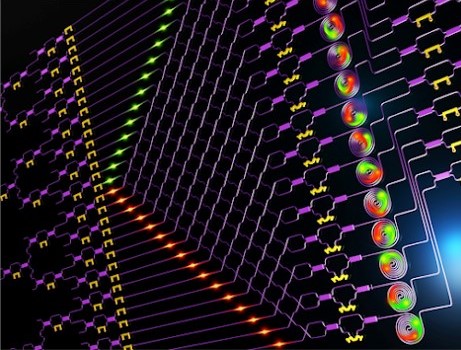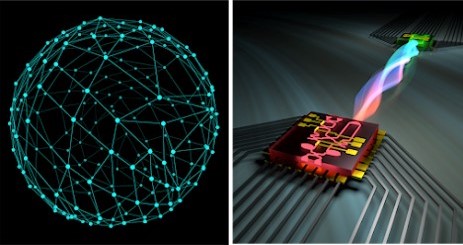Integrated quantum photonic devices and circuits

The devices and circuits able to generate, process and detect quantum states of light are at the heart position of implementing quantum protocols and algorithms.We are developing integrated quantum photonic devices and circuits in a range of material systems, for example silicon nanophotonics, a profound platform that is comparable with the CMOS technology and able to monolithically integrate single-photon sources, linear-optic circuits, and single-photon detectors. Integrated quantum photonics, having the high-level of controllability and programmability and the capability of achieving a very large-scale integration of quantum IC [Science 385, 285-291 (2018)], allow unprecedented applications in fundamental science and quantum technologies.
Chip-scale quantum communication network

Integrated photonics is a well-established technology in the global telecommunication industry, as such it is also natural to adopt integrated photonics for practical quantum communication to transmit and receive encrypted keys. Chip-based quantum communication networks require the coherent transmission, distribution and process of entangled states [e.g, Optica 3, 407-413 (2016)], as well as the coherent trancieving and teleportation of quantum states [e.g, CLEO PDP JTh5C.4 (2019)], in which photons are flying amongst separate chip-scale subsystems. We are developing quantum communication technologies with photonic chips, particularly in silicon that is known comparable with the telecommunication infrastructure and CMOS electronics. We are also seeking a further integration of stationary qubits in matter with flying qubits for quantum information storage in the network.
On-chip quantum simulations with photons

Quantum simulation is to simulate and predict the behaviors of a complex quantum system by a controllable quantum machine–the system is approximated by an abstract model running in the machine. Such quantum simulator provides a powerful platform to study complex physical and chemical systems, such as computing molecular dynamics [e.g, Science Advances 4, 96946 (2018)], a intractable task in classical computer. A question is how to certificate their simulation results? By measuring the consistency of the model predictions from the simulator with the real experimental data and by estimating their quantum likelihoods, it can efficiently simulate and characterize the underpinning Hamiltonian models and verifying the predictions [Nature Physics 13, 551-555 (2017)].
Quantum computing and information processing

Photonics is a leading physical system for the implementation of both specific quantum computation such as Boson sampling and universal one-way quantum computation. The former is a leading candidate for quantum supremacy, while the later shows solid progress towards large-scale quantum computing. We are currently developing scalable on-chip Boson samplers [e.g, Nature Physics 15, 925-929 (2019)] and new chip-scale quantum computing machines [e.g, Nature Photonics 12, 534-539 (2018)]. Distinct to other implementations, manufacturing wafer-scale photonic circuits in silicon needs "near-zero-change" of current CMOS fabrication process. This promises significant enhancement of the quantum information processing capability, given the possibilities of large-scale integration of quantum circuits and processing of large-number of photons.